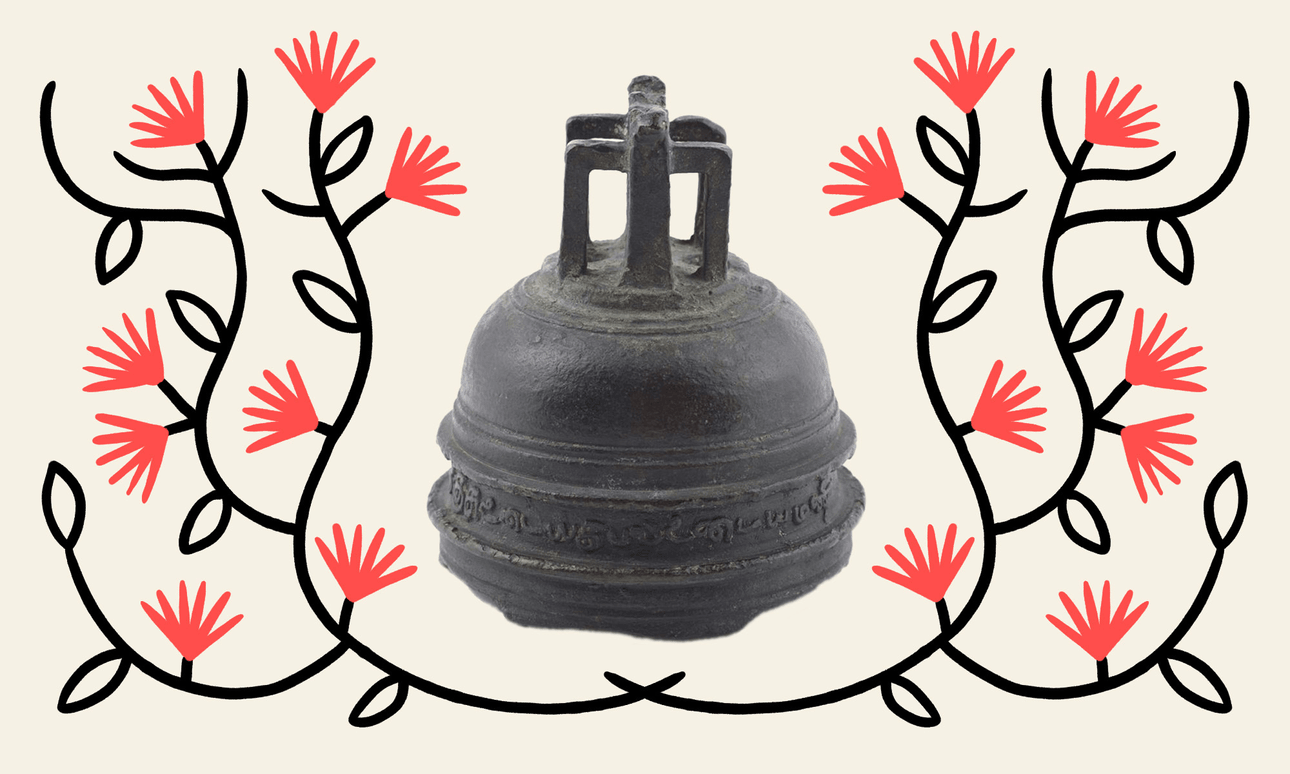In Wellington, a group of Tamil New Zealanders have been learning te reo Māori. One of the group’s leaders says it’s been an opportunity for growth, ako and building important cultural connections.
In the archives of Te Papa sits a rather unassuming bronze bell. It’s small – just over 16cm high and 15cm wide – and contains an inscription running around its base in Tamil.
But the origins of the bell are far more of a mystery than its modest appearance may let on. In the mid-19th century, a missionary named William Colenso came across an iwi that used the upturned bell as a cooking pot, to boil their potatoes. Colenso was told the bell had been uncovered from the roots of an upturned tree, where it was buried until a storm pulled it from the earth, and that it had been in the possession of the Whangārei iwi for several generations.
How it got there remains a mystery. It’s one that many have tried to solve – was the bell from a Portuguese ship, wrecked somewhere off the coast? Or did it belong to an ancient Tamil people with a far more complex knowledge of the Pacific than currently believed?
While the exact details of its past may be unclear, for Ravindran (Raveen) Annamalai the bell is a symbol of a connection between Tamil and Māori people. It’s a connection Annamalai has been building upon for himself and his community ever since he arrived in Aotearoa.
“I felt that I needed to be more connected with the tangata whenua of New Zealand, and how could I do that?” he asks. “I started by building out my own Tamil community. The Tamil language is the oldest language in the world, and we found a lot of similarities between Māori culture and the Tamil community.”
Those similarities inspired Annamalai to seek out meaningful ways to engage with iwi in his home town of Wellington – bringing with him on this journey the Tamil community he had spent so long nurturing.
“There are a number of similarities with Māori and Tamil cultures. How we observe prayer, starting hui and eating times with a karakia – all of that is very similar. This is a country that I call home, so I need to make sure that I understand the indigenous people of this country… I want to tell all of my people that we need to come together to raise this flag to value the cultural foundation of this country.”
The president of Aotearoa New Zealand Federation of Tamil Sangam (ANTS), Annamalai has been part of the Tamil New Zealand community in Wellington for 18 years – as a community leader and volunteer, as the chair of the Multicultural Council of Wellington and as one of the founding members of Wellington Mutamizh Sangam, the local Tamil association in the capital.
Aware that many new migrant families in his community were primarily focused on getting their family settled, Annamalai recognised this resettling process could benefit from an introduction to te ao Māori – to showcase the cultural similarities between migrants’ old and new homes and bridge the cultural gap that so many new migrant families feel daunted by.
“When they are moving here as a migrant, many people’s primary focus is trying to settle down as a family,” he says. “I want to make sure people know what we are doing as a community in embracing, acknowledging and respecting the values of the tangata whenua in this country.”
With the help of Te Taura Whiri i Te Reo Māori, ANTS organised te reo Māori classes, which are now attended by people from both within his Tamil networks and outside of them.
“I am proud of our te reo Māori classes at the Newlands community centre in Wellington. We have people coming from all different backgrounds, not just Tamil but Pākehā, even people from across the world in places like Portugal are joining.”
These classes led to the creation of six Tamil/Māori hui held at marae across the country. Annamalai is currently helping to plan the second of these for early 2023 in Tāmaki Makaurau. The first, held at Waiteti Marae in Ngongotaha, Rotorua, was attended by more than 250 Tamil community members over its two days.
The hui included panel discussions about multiculturalism and biculturalism in Aotearoa, performances in Tamil and speeches from race relations commissioner Meng Foon and deputy commissioner of police (iwi and communities) Wallace Haumaha, who said the hui was the beginning of “a journey to a more inclusive, connected and Treaty-centred Aotearoa.”
Annamalai knows his personal journey of learning te reo Māori will be a lifelong one, but his goal is to be able to have a conversation in te reo Māori within the next two years. For him, the doorway to understanding te ao Māori in a more meaningful way is learning the reo.
“When you speak the language of other people, you become closer and more attached to them. This opportunity that I am enjoying at the moment, I want to share with my fellow people.”
Follow our te ao Māori podcast Nē? on Apple Podcasts, Spotify or your favourite podcast provider.
Ultimately, Annamalai is so passionate about his te reo Māori journey because he understands the privilege of being gifted the knowledge and time from those teaching him. He wants this privilege to be extended to as many people as possible, so that the korowai of mātauranga can wrap around his community too.
“Learning te reo Māori is one thing. Understanding, acknowledging and embracing the indigenous people of this country, New Zealand, is a significant thing that I as a leader am conveying to my fellow Tamil community members.”
While it may not be known how the Tamil bell arrived in Aotearoa, its legacy is seen in the new connections that have been formed through the work of Annamalai and his community. Now he’s ready for that bell’s chime to ring out even louder.

